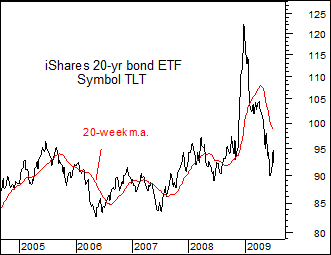A Case For U.S. Treasury Bonds!
Interest-Rates / US Bonds Jun 27, 2009 - 04:17 AM GMTBy: Sy_Harding
 There’s an old saying that goes like this; “The market will do whatever it must to fool the majority of investors”. It’s another way of describing investor sentiment, which is known as a ‘contrary indicator’ (because the majority of investors are extremely bullish at important market tops, and extremely bearish at important bottoms).
There’s an old saying that goes like this; “The market will do whatever it must to fool the majority of investors”. It’s another way of describing investor sentiment, which is known as a ‘contrary indicator’ (because the majority of investors are extremely bullish at important market tops, and extremely bearish at important bottoms).
With that thought in mind let’s look at U.S. Treasury bonds.
Could they be more unwanted, more encapsulated in bearish sentiment?
After all, who would buy U.S. Treasury bonds? The U.S., already the world’s largest debtor nation, is committing several $trillion to rescuing its financial system and re-stimulating its economy. In order to come up with the cash it has to print more dollars, and sell more debt in the form of treasury bonds than it ever has in its history. As in any market increased supply results in falling prices.
Then there is the fact that, thanks to years of record trade deficits with its trading partners, foreign countries have become major holders of U.S. bonds, the excess dollars from their exports being held in U.S. bonds and other dollar-denominated assets. (China alone holds $763 billion of U.S. Treasury bonds).
Already the decline in bond prices has foreign countries, notably China, Brazil, and Russia making noises about converting some of their dollar-denominated reserves to other currencies, calling for the International Monetary Fund to issue bonds backed by a ‘basket’ of global currencies, as a means of doing so.
Additionally, it’s a foregone conclusion, at least in current popular wisdom, that the soaring federal debt will result in hyper-inflation down the road. And bonds despise inflation, an inflationary rise in interest rates causing bond prices to plunge.
It’s a compelling story.
However, last fall, when the potential collapse of global banking systems created fear that there were no safe havens anywhere, not in the stock market, not even in bank savings accounts, U.S. bonds regained their global stature as a safe haven. The panicked frenzy to move money into them created what I described in December as a bubble, with for instance the iShares 20-year bond etf (symbol TLT) becoming extremely over-extended above its 20-week m.a. I issued a sell signal on January 5, recommending the purchase of the ‘inverse’ etf on the 20-year bond, warning that the downside of bubbles is almost always the mirror image of the spike up.

Sure enough, bonds peaked in early January and their severe plunge since certainly has them unloved and unwanted now.
However, I believe a positive case can now be made for U.S. Treasury bonds again.
From the technical side, in their plunge after their previous bubble burst in January bonds have become extremely oversold beneath their 20-week moving average.
On the investor sentiment side, bonds could hardly be more unloved and unwanted, positive commentaries on bonds now few and far between.
On the fundamental side, for two basic reasons the government is going to do whatever it must to try to bring interest rates down, bond prices up. First of all, mortgage rates are tied to the yield on 10-year Treasury bonds. Recently rising bond yields, resulting from falling bond prices, have mortgage rates rising at a time when the government desperately needs them to decline, if there is going to be any success in getting a housing recovery underway. Secondly, a renewed rally in bond prices would calm the concerns that global central banks might begin to withdraw from dollar-designated assets, just at a time when their support is most needed.
The Federal Reserve realizes that, and in March announced it would buy $300 billion of Treasury bonds on the open market between March and September. So far it has completed $178 billion of that commitment. It indicated a couple of months ago that it would increase its commitment to as much as $1.2 trillion if necessary.
But you ask, what about the hyper-inflation that surely lies down the road as a result of the excessive printing of money by the Treasury Department?
That has been the popular bet this year, with gold, the age old hedge against inflation having mounted four rallies in anticipation of that promised inflation showing up within months.
But each gold rally has ended at approximately the same level, around $1000 an ounce, on realization that for now the economy is still in a deflationary situation, that potential inflationary pressures are still some way down the road, and on comments from the Fed that it is well aware of the possibility of inflation down the road and will act to tighten monetary policy well before hand.
So, putting together the technical, sentiment, and fundamental issues, I believe it may again be time to consider treasury bonds, and the iShares Lehman 20-year T’Bond etf, TLT.
Sy Harding publishes the financial website www.StreetSmartReport.com and a free daily market blog at www.SyHardingblog.com.
Disclaimer: The above is a matter of opinion provided for general information purposes only and is not intended as investment advice. Information and analysis above are derived from sources and utilising methods believed to be reliable, but we cannot accept responsibility for any losses you may incur as a result of this analysis. Individuals should consult with their personal financial advisors.
© 2005-2022 http://www.MarketOracle.co.uk - The Market Oracle is a FREE Daily Financial Markets Analysis & Forecasting online publication.



